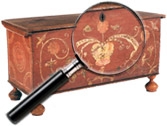Rudolf Levy (German, 1875 to 1944)
Levy was the scion of a prosperous Jewish merchant family. He originally enrolled in the Grand Ducal School for Decorative and Applied Arts in Baden in 1895 to study carpentry, but left that University in 1897 when he decided to pursue painting at the various, well-lauded private art schools in Munich.
In Munich, Levy studied with Nicolas Gyzis, Heinrich Knirr (1862-1944), and the noted Symbolist painter Franz von Stuck (1863-1928). Later, Levy was accepted into the prestigious plein air studio of Heinrich von Zugel (1850-1951) where he was exposed to German and French Impressionists. In 1903 Levy decided to move to Paris and once there associated with the circle of artists and intellectuals who congregated at the Cafe du Dome, the well-loved Montparnasse bohemian bar. These artists, including Oskar Moll and Hans Purrmann, were affectionately referred to as “Domiers”.
Shortly after moving to Paris, Levy began exhibiting his work and was featured in the Autumn Salon of 1905. In 1907 he entered the newly established workshop of Henri Matisse where he was considered one of Matisse’s most important and talented German students. In 1912 Levy took part in numerous exhibitions across France, Germany and the Netherlands, most notably in Cologne at the Sonderbund and in Amsterdam at the Stedelijk Museum. He was also one of the German artists who exhibited at the Armory Show in New York in 1913. When W.W.I began, Levy returned to Germany and volunteered for the Front; he ended up fighting against his beloved France. After the Armistice, Levy moved to Berlin to continue pursuing painting.
He had a series of one-man shows at Alfred Flechtheim’s prestigious Gallery. Until his emigration from Germany in 1933, Levy was on the board of directors and a jury member of the Berlin Secession. Once he left Germany, fearing the political climate, he traveled to Mallorca, Spain, and New York, eventually settling in Italy. During W.W.II, Levy’s paintings were removed from German museums and art institutions. In December 1943 Levy was arrested by the National Socialists in Florence and placed on a transport train en route to the Capri internment camp in Modena, which was a gathering station for Auschwitz. He was never heard from again.
Levy’s works have been in numerous exhibitions over the past several years including the New York Studio School’s “Academie Matisse,” the Galerie Sander’s “German Art from Impressionism to Expressionism,” the Stiftung Wilhelm Lehmbruck Museum’s “50 German Masterpieces Created Between 1900-1950,” and the Musee de Montparnasse’s “Montparnasse Deportees.” This last was an exhibition created as a memorial to the over 100 emigre artists who had made the Montparnasse area their haven, and who were deported by the Nazis to camps or ghettoes.
References: Montparnasse Deporte Shalom Vol. XLV/Printemps 2006/Pessah 5766, Montparnasse Deporte, The End of L’Ecole de Paris Yad Vashem Vol. 40/Winter 2006.
Information courtesy of Neal Auction Company
